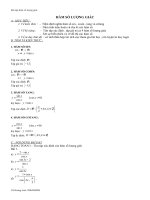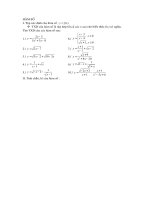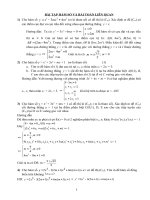bài giải đạo hàm và định lý lđảo
Bạn đang xem bản rút gọn của tài liệu. Xem và tải ngay bản đầy đủ của tài liệu tại đây (116.91 KB, 2 trang )
THE FOURIER TRANSFORM AND THE MELLIN TRANSFORM
For suitable functions
f : R −→ C
the Fourier transform of f is the integral
Ff : R −→ C,
f (x)e−2πixy dx,
(Ff )(y) =
R
and for suitable functions
g : R −→ C
the inverse Fourier transform of g is the integral
F −1 g : R −→ C,
(F −1 g)(x) =
g(y)e2πiyx dy.
R
The Fourier inversion formula says that if the functions f and g are well enough
behaved then g = Ff if and only if f = F −1 g.
The exponential map is a topological isomorphism
exp : (R, +) −→ (R+ , ·)
The Mellin transform, inverse Mellin transform, and Mellin inversion formula are
essentially their Fourier counterparts passed through the isomorphism.
Specifically, given a suitable function on the positive real axis,
f : R+ −→ C,
we can make a corresponding function on the real line,
f : R −→ C,
f = f ◦ exp .
The Fourier transform of f is F f : R −→ C where
f (x)e−2πixy dx
(F f )(y) =
R
f (ex )(ex )−2πiy
=
R
f (t)t−2πiy
=
R+
f (t)ts
=
R+
dt
t
d(ex )
ex
dt
t
letting s = −2πiy.
If f (t) decreases at least as a polynomial in t as t → 0+ and f decreases rapidly
as t → ∞ then in fact the integral converges on a complex right half plane of svalues {Re(s) > σo } where σ0 < 0. More generally, if f (t) behaves asymptotically
as t−σo where σo ∈ R as t → 0+ , and f (t) decreases rapidly as t → ∞, then the
integral converges on a complex right half plane {Re(s) > σo }. Thus we are led to
define the Mellin transform of f for such functions f
dt
Mf : {Re(s) > σo } −→ C, (Mf )(s) =
f (t)ts .
t
+
R
1
2
THE FOURIER TRANSFORM AND THE MELLIN TRANSFORM
The condition that (F f )(y) is small for large |y| says that (Mf )(s) is small for s
far from the real axis.
For example, the gamma function is the Mellin transform of the negative exponential,
dt
Γ(s) =
e−t ts
, Re(s) > 0.
t
R>0
Letting g = Mf (so that g(s) = Mf (s) = (F f )(y) when s = −2πiy), the next
question is how to recover f from g. Since g is simply the Fourier transform of f
up to a coordinate change, f must be essentially the inverse Fourier transform of g.
More specifically, the fact that f is exactly the inverse Fourier transform of F f ,
(F f )(y)e2πiyx dy,
f (x) =
R
rewrites as
g(s)(ex )−s dy
f (ex ) =
where s = −2πiy
R
=
1
2πi
g(s)(ex )−s ds integrating upwards.
Re(s)=0
That is,
1
g(s)t−s ds.
2πi Re(s)=0
Contour integration shows that the vertical line of integration can be shifted horizontally within the right half plane of convergence with no effect on the integral.
Thus the definition of the inverse Mellin transform of g is inevitably
1
M−1 g : R+ −→ C, (M−1 g)(t) =
g(s)t−s ds for any suitable σ.
2πi Re(s)=σ
f (t) =
Naturally, the Mellin inversion formula says that if the functions f and g are well
enough behaved then g = Mf if and only if f = M−1 g.
For practice with Mellin inversion, it is an exercise to evaluate the integral
σ+i∞
Γ(s)t−s ds,
f (t) =
s=σ−i∞
σ > 0.









